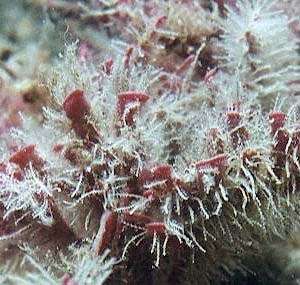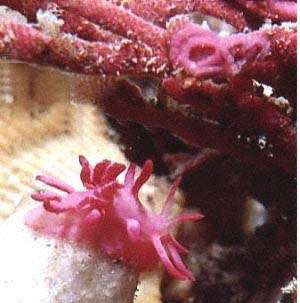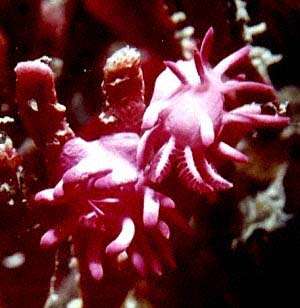Observations on Hopkinsia sp.
January 29, 1999
From: David Atkinson

Note added 10 Dec. 2007: This species has been identified as Okenia atkinsonorum [see message #21273].
Hi Bill,
Hope you are well an the road to recovery and that you had a great festive season !
We had a dive at Halifax on Saturday and had a look at our "Pink Wall" (an 8m X 2m strip of pink bryozoan at 22m ). This is where we can always find our Hopkinsia sp nudis.
The bryozoan seems to have been largely overgrown by a Hydroid ?? which seems to make it unpalatable to Hopkinsia sp. Numbers are down on normal. The animals we did find were on the hydroid free areas.
One picture (BELOW RIGHT) shows mating ? Another (BELOW LEFT) shows Hopkinsia eggs in the top right corner of photo?
The other (TOP RIGHT) shows the bryozoan "infestation" with hydroid ? What is the pink bryozoan ?
David Atkinson
atkin@hunterlink.net.au


Dear David,
Yes I'm well and had a good Christmas break. Thanks for the interesting pictures. Yes the bryozoan is being overgrown by hydroids. This bryozoan often has hydroids growing on it, but usually just a few as in the photo at the top of the page. All sessile organisms (ones that are fixed and can't move away) in the sea have a problem with "fouling organisms" which are plants and animals which settle on and smother sessile organisms. Fouling organisms get their name because they are a major problem when they foul the bottom of boats. They often have very short lifecycles, growing rapidly to maturity. they settle on all bare surfaces.
Many sessile plants and animals have evolved mechanisms to keep fouling organisms at bay, through chemicals and special structures. This bryozoan clearly hasn't succeeded. Nudibranchs, even those that feed on cnidarians, are usually not immune to hydroid nematocysts, so it unlikely that Hopkinsia would be much use in clearing an area already overgrown with hydroids. Quite possibly the hydroids have affected the Hopkinsia population by preventing larval nudibranchs from settling out of the plankton, or by eating the larvae.
I am not sure that your two animals are mating. They have their reproductive apparatus on the right side of the body so during mating they need to be aligned so their right sides are touching. Your animals may be thinking about it but I don't think their right sides are together.
The pink bryozoan's name, Pleurotoichus clathratus, is at the top of the page. Thanks for this information. I don't think I have seen the egg mass of this species before.
Best wishes,
Bill Rudman.
Related messages
-
Re: Okenia atkinsonorum - another pink species
From: Leanne & David Atkinson, January 31, 2008 -
Okenia atkinsonorum? from New Zealand
From: Ian Skipworth, December 10, 2007 -
More photos of Okenia atkinsonorum
From: Bill Rudman, December 10, 2007 -
Okenia atkinsonorum - another pink species
From: Bill Rudman, December 10, 2007 -
Okenia hallucigenia from Bare Island, Sydney
From: R. Fea & J. Coombs, May 9, 2005 -
Re: Okenia cf. hiroi from New Zealand
From: Ian Skipworth, January 26, 2005 -
Okenia hiroi? from New Zealand
From: Ian Skipworth, January 25, 2005 -
Hopkinsia sp. laying eggs
From: Leanne Atkinson, March 4, 2003 -
Hopkinsia from Sydney
From: Allan Saben, February 8, 2003 -
Totally pink!
From: Bill Chambers, January 13, 1998
